How many years ago did I first learn about this brand?
"Kesennuma Knitting" started in 2011.
The founder is Shigesato Itoi.
Kesennuma City, Miyagi Prefecture was severely damaged in the 2010 Great East Japan Earthquake.
It also started as a symbol of that recovery.
In Kesennuma City, a fishing town, many women knit sweaters by hand, similar to British fisherman sweaters.
"Hand-knitted sweaters" can be called a culture and tradition that is rooted in the region.
Nowadays, even in England, where sweaters used to be knitted by hand, most sweaters are now machine knitted, and this method of producing sweaters is gradually disappearing.
Kesennuma Knitting is a brand whose sweaters are all hand-knitted by the people of Kesennuma.
One person handles the entire garment from start to finish.
As I have written on this blog, the first brands I bought from were "Yamauchi" and "MOTHER HAND artisan" about 7 years ago.
A little while after I started selling MOTHER HAND artisan, I thought of another brand that made sweaters, and the two that came to mind at the time were "The Inoue Brothers" and "Kesennuma Knitting." .
Both create something very meaningful to the world.
Among them, The Inoue Brothers did not own a sweater, but they had large blankets and socks that they had been using for a long time, and although they were familiar with Kesennuma knitting, at that time they did not know how to handle it. There were no stores that had a precedent for doing so, and I didn't really know how to contact them, so I decided to sell The Inoue Brothers and gave up on Kesennuma Knitting.
This was probably five or six years ago.
And so, time has passed, and this year, 2023. I guess there's a connection.
At that time, our store was contacted by Kesennuma Knitting, which had given up on handling it.
Could you handle it anew? how is it. That's it.
This surprised me.
I can't wait to go around and get some contact.
Kesennuma Knitting is run by Mizuko Mitarai.
He has a clear goal and continues to do consistent things in Kesennuma with that goal in mind.
For that reason, it is not a fashion brand. That's my interpretation.
Mr. Mitarai heard about our store after seeing select shops from all 47 prefectures in Japan featured in the magazine BRUTUS.
According to Mitarai-san, there is one shop in Kesennuma that is perfect for knitting, but with one different feel. That's what he thought.
Originally, Kesennuma Knitting had a directly managed store called "Memories" in Kesennuma City, as the name suggests.
It seems that they previously had a directly managed store in Kitasando, Tokyo, but I think it was due to the effects of the coronavirus, but they have closed that store and are not doing much wholesale business in the first place.
Occasionally, Mitarai would have the opportunity to see it in the form of a limited-time event in some city around the country, but due to Mr. Mitarai's own circumstances, it became difficult for him to travel around the country like that. yes.
For that reason, she was looking for a place where she could introduce Kesennuma knitting.
BRUTUS at such a timing.
Also, I will be handling Kesennuma knitting, which I had previously envisioned myself, and introducing it to everyone.
In this way, matching.
Originally, I was planning to change the fashion cycle a bit and show you this in December, when it's getting colder, so I thought I'd take this opportunity to introduce it to you.
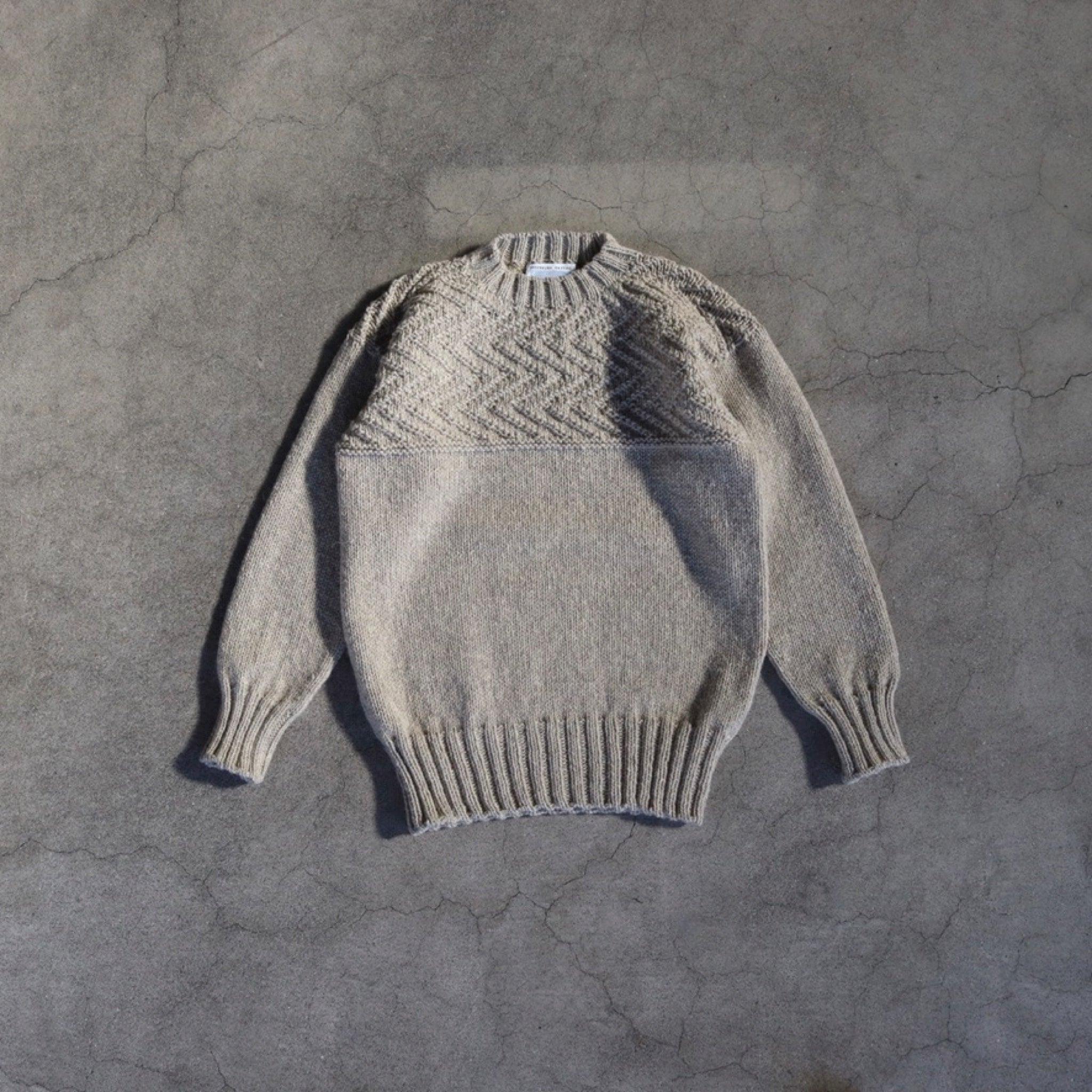
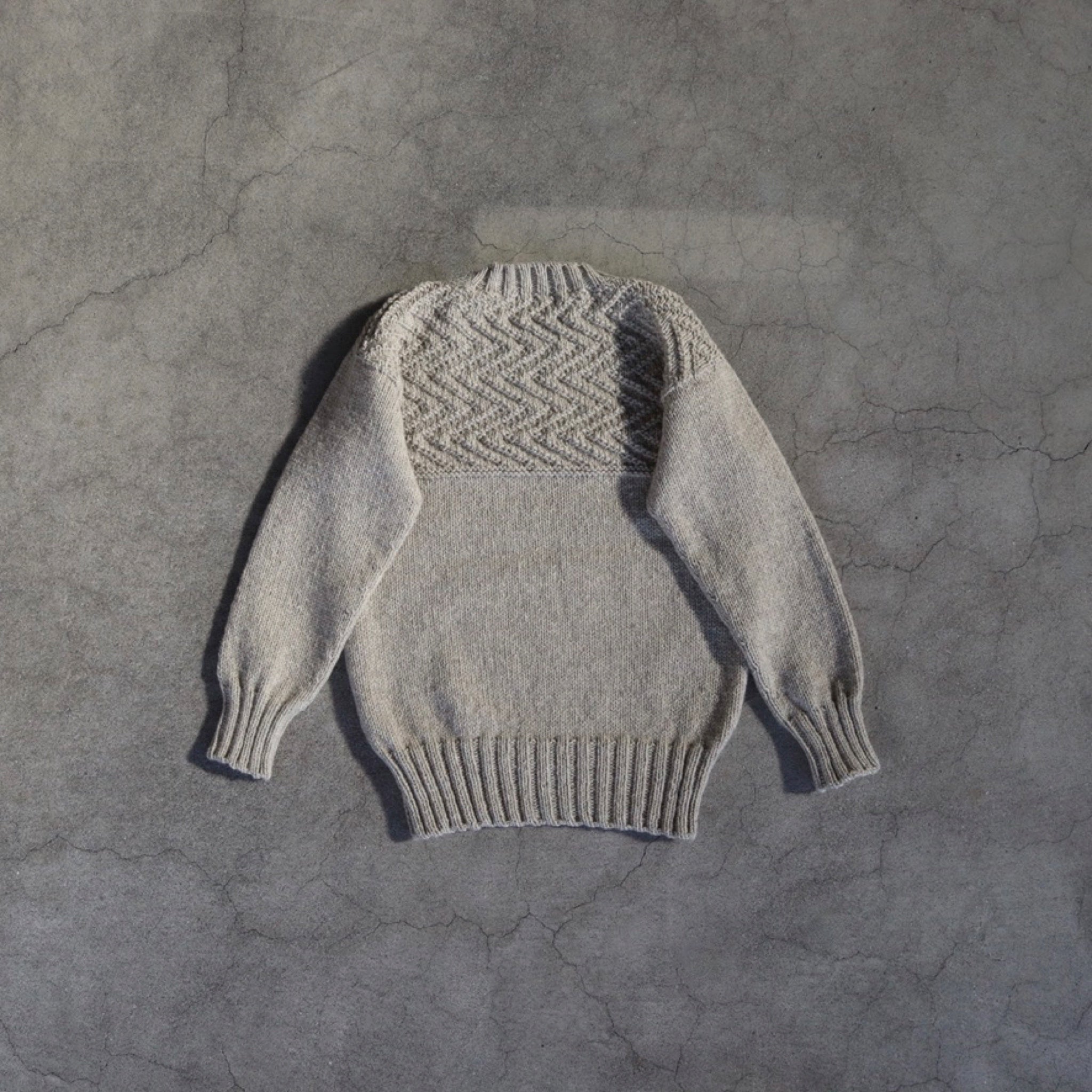
Kesennuma knitting
etude
material_WOOL 100%
color_OATMEAL
size_S,M,L
price_ ¥88,000-(in tax)
this.
A model called "etude" that is entirely hand-knitted and has a Gandhi sweater motif.
Kesennuma Knitting has other products in its lineup, but select shops like ours rarely have them, so after discussing various things with Mr. Mitarai, we decided to start with this "etude". I decided to deal only with the model.
The only color is oatmeal.
Size S is for women.
M is a standard size for men, and L is a large size for men.

All of Kesennuma Knitting's sweaters come with tags like this.
It includes the portrait, name, and serial number of the person who knitted this sweater.
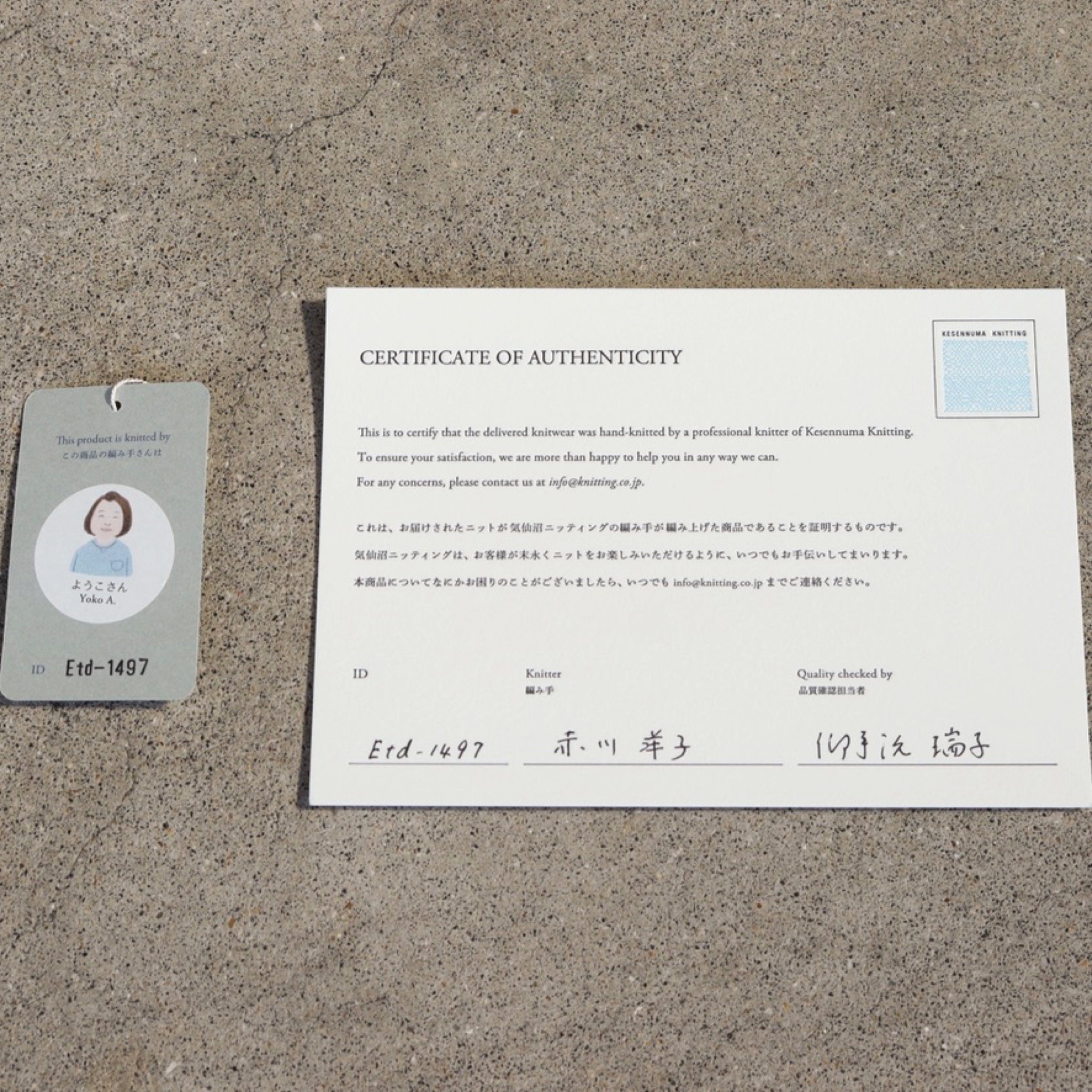
this.
The sweater itself will be delivered in a box, but the name of the person who knitted it will be handwritten on it.
And Mitarai's name too.
When I talked with Mr. Mitarai, I got the feeling that a lot of thought went into the Kesennuma Nittig even before it started.
At first, it started by making several cardigans, but now the number of knitters has increased little by little, and the circle of people who make them and those who wear them has expanded.
This sweater is knitted by ordinary people, but to be frank, it is not Shiroto's work. not at all.
If that's the case, I'll never handle it.
Originally, hand-knitted knits have been rooted in the local culture since ancient times.
I practice over and over again, over and over again, until I can achieve the "standard" set by Kesennuma Knitting.
She says she will continue weaving until it reaches first-class quality.
I think everyone who sees the finished sweater will be satisfied with it.
You can feel the bulge of the knitted fabric, the softness, the detailed processing, the feeling of wearing it, and the radiance of the sweater itself.
The MOTHER HAND artisan sweaters that we carry in our store can be called "God's knits" and are made using home hand flat knitting machines, but our store also has world-class quality sweaters. Ta.
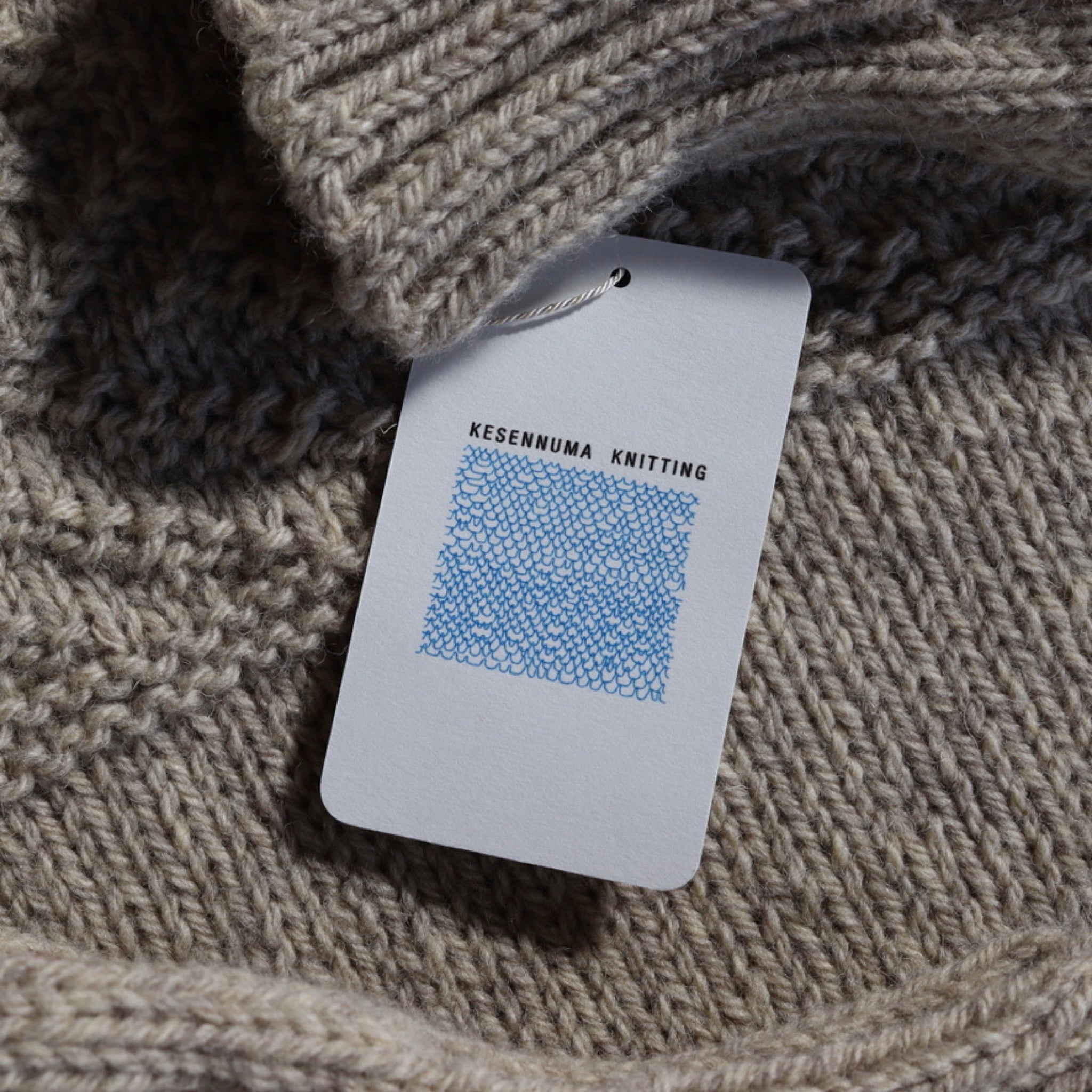
After getting in touch with Mr. Mitarai, I actually saw Kesennuma Knitting's actual sweater many times and talked with Mr. Mitarai many times.
Since Kesennuma and Okayama are fairly far apart, we can do it by phone and Zoom. lol
And what I definitely felt was that Mitarai-san's "serious heart" really oozed into the sweater. That's what I mean.
Personally, the moment I laid eyes on the actual sweater, I felt something very special about it.
After all, I was really curious about what the people who were working as leaders were thinking.
From there, the first thing that struck me was the overwhelming confidence in the quality of Kesennuma Knitting's sweaters.
I love it when the person making it has a lot of confidence, and I think that's how it should be.
However, the confidence I feel from Mr. Mitarai is not a blind confidence, but one that comes from what we have done so far, what we have accumulated as Kesennuma Knitting, and the fact that we have not made any compromises since the beginning. I thought so.
Kesennuma knitting is
I place great importance on "what lies beyond."
I think this sweater really conveys that.
As Mr. Mitarai says, ``The person who makes it is happy, and the person who wears it is also happy.''
The knitters carefully and carefully spend dozens of hours knitting each sweater, imagining what kind of person would wear the sweater they have knitted.
Authentic "handmade work".
And the finished sweater is The "heart" dwells in this piece, and on top of that, it has a warmth that feels like it has been forgotten, and as mentioned above, it is first-class quality.
Clothes that bring joy to the person who holds them, and a chain of happiness, are extremely present.
That is one of the great powers of "Kesennuma Knitting".
"Who is thinking and creating it?"
I think this is a very important thing when it comes to manufacturing in the world.
Japanese people, who are supposed to be well-educated by a global standard, have stopped thinking deeply about things, or rather, I think we've become a world where this has not been ingrained in them, and they have to endure a lot of hardship and patience. Things that require strength and troublesome things. I think that kind of thing is rarely done anymore.
Everything is moving in the direction of being rational, efficient, and time-saving.
The same goes for the clothing industry.
Even people who run brands and are called "designers" may not be able to make their own clothes, let alone draw pictures of them, and even more so, they may not fully understand their own brand's clothes. I even come across situations where there is no such thing.
I think it's because there are so many things that at first glance appear to be easy to pass.
For me, that kind of clothing is not acceptable.
I think clothes have the power to greatly move people's hearts, and as I sometimes write about on this blog, I think they can positively change even one person's life.
Originally.
But now, too many clothes are shallow.
Moreover, the quality of such clothes is often judged through the screen of a smartphone.
Furthermore, I think that the "good" or "bad" aspects of clothing mostly come down to its visual design and how easy it is to coordinate with other outfits.
A design that combines copies of things that already existed in the world.
Under such circumstances, I believe that the value of clothes, which are truly precious objects, will never increase, and Japan's ``clothing culture'' will never grow.
And the current situation is that Japanese clothing manufacturing is definitely in decline.
At the moment, I feel that the value of ``cheaper is better'' has become a little weaker than it was before due to the rise in prices of everything, but that's about to happen.
Personally, I think that when it comes to clothes, the important factor is whether or not they look cool at the entrance, and whether they look cool or not at the exit.
However, I don't think it's really about whether it's cool or not.
Important things are packed between the "entrance and exit", and things are greatly influenced by that point.
Therefore, when it comes to clothes, the ``contents'' are extremely important.

The brand Kesennuma Knitting is truly overwhelming.
The other day, we had Kaneta Orimono and Fashion Izumi, who are upstream in the clothing industry and have the skills and enthusiasm, to come to our store and sell clothes made from a fiber called Suvin Gold Supreme.
These three major pillars are what I offer to everyone: such things, ideas like Kesennuma Knitting, and dealing with a brand that produces unique creations that are sometimes overwhelming and can't be described in words, not only in Japan but also overseas. That's what we want to continue to convey, and that's what the select shop CASANOVA&CO is all about.
A retail store is not just about buying and selling things.
When categorized into "upstream, midstream, and downstream," we, as a select shop, are in a position closest to the general customer in the clothing industry.
So, although it may be a 0.000001% chance, we may be able to influence people's perceptions of clothes, their way of thinking, and their values in a slightly positive direction.
That's what I believe in.
Well, for the past year or more, I've been constantly thinking about the meaning of my existence.
However, I am also being encouraged by people and designers I truly respect, including Kesennuma Knitting, which I am introducing today.
This blog is extremely long, and it's kind of hard to write, but it's because director Hayao Miyazaki said this on NHK's ``Professional ~Work Style~''.
``Most important things are troublesome.''
In this world, important things are not easy.
That applies to anything.
In that sense, I think it's the most analog, the most human-involved, and the most directly reflective of the creator's humanity.
Kesennuma knitting.
As I said earlier, MOTHER HAND artisan, the "God's knit" that we have carried in our store, also makes extremely difficult and dangerous products, but starting this year, we will be introducing these two major sweater brands to everyone. I'll take it.
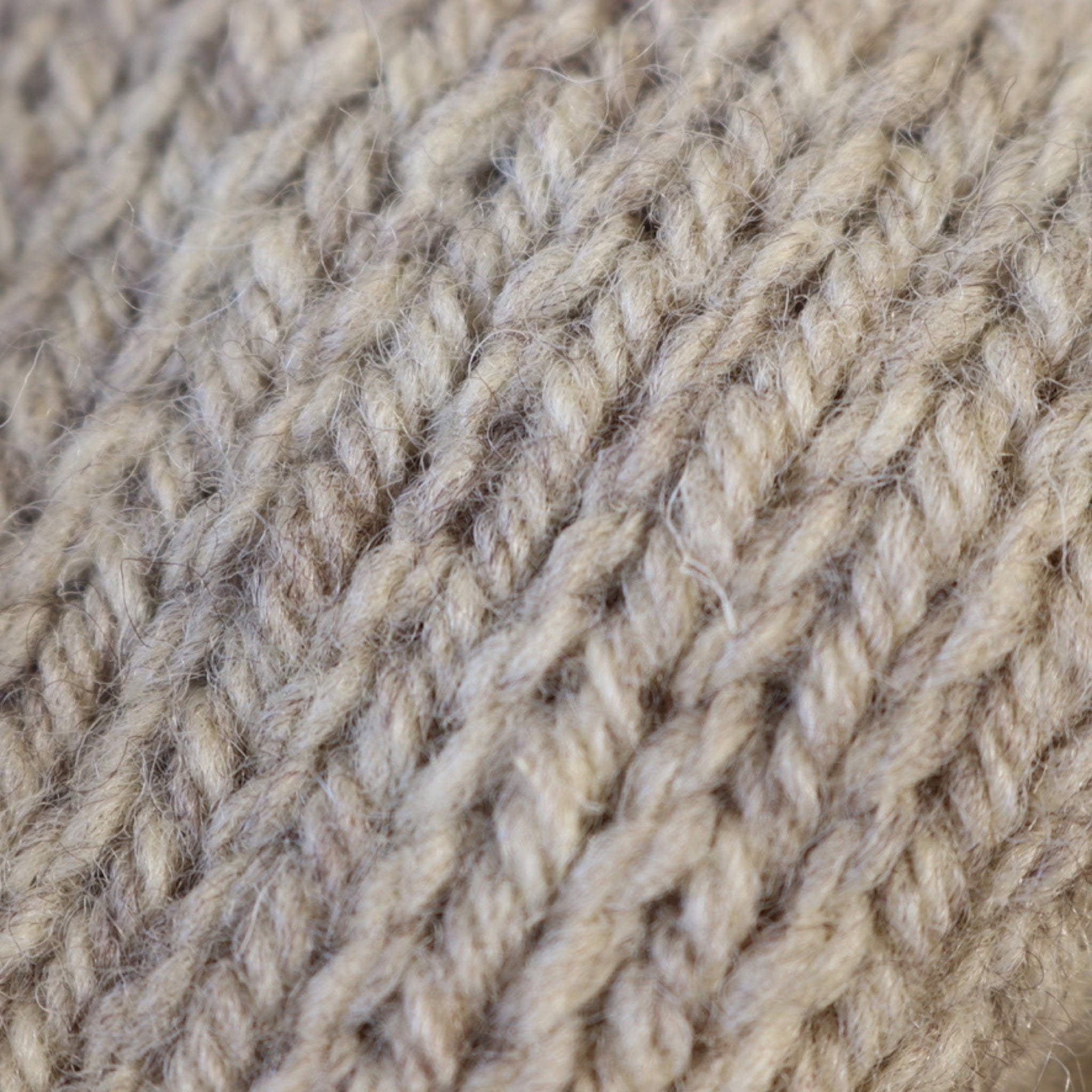
The material is 100% wool.
Nowadays, I think there are very few clothing brands that are seriously competing with 100% wool sweaters.
The wool of Kesennuma knitting has no scratchy feeling.
Now, if someone says it's tingling, we're already at the level where we can't give up.
When starting the brand, he went to the Aran Islands in the UK, Ireland, to research fisherman's sweaters, and from that time on, he thought about creating an "original" yarn using Kesennuma Knitting.
Wool fibers are generally made by blending the wool of multiple types of sheep, but at Kesennuma Knitting, we are concerned with which types of sheep to blend together and in what proportions. It seems that they have repeatedly conducted research and prototype production.
In England, where fisherman's sweaters have been popular for a long time, the sea breeze is strong, and to protect themselves from the strong sea breeze, the threads are made stiffer and the eyes are tightly packed.
As a result, it feels stiff and is not at all comfortable to wear.
However, the unique knitting pattern is three-dimensional and stands out beautifully.
In order to achieve the ideal sweater texture for Kesennuma Knitting, we created an original yarn with a "unique recipe" in Kyoto that is unique to the world.
This is really amazing.
We also asked them to produce it in OATMEAL, which is not a single color, but a mixture of multiple colors, which is characterized by its gentle colors.

As shown in the photo, when you open your arms, they are in a straight line.
Etude has the most classic hand-knitted sweater shape.
As a result of long-term wear, the wearer's shoulders naturally become rounder.
Wool breathes, and gradually, over time, it becomes familiar to the person who owns it, depending on the humidity of the outside air and body temperature.
And, compared to machine-knitted sweaters, the thicker threads swell and naturally close the stitches, giving it even more warmth and texture.
I think you can feel the benefits of a hand-knitted wool sweater to the fullest.

Since it is hand knitted, there is no neck seam, unlike machine knitted sweaters.
The knitted fabric is connected to form a shape.


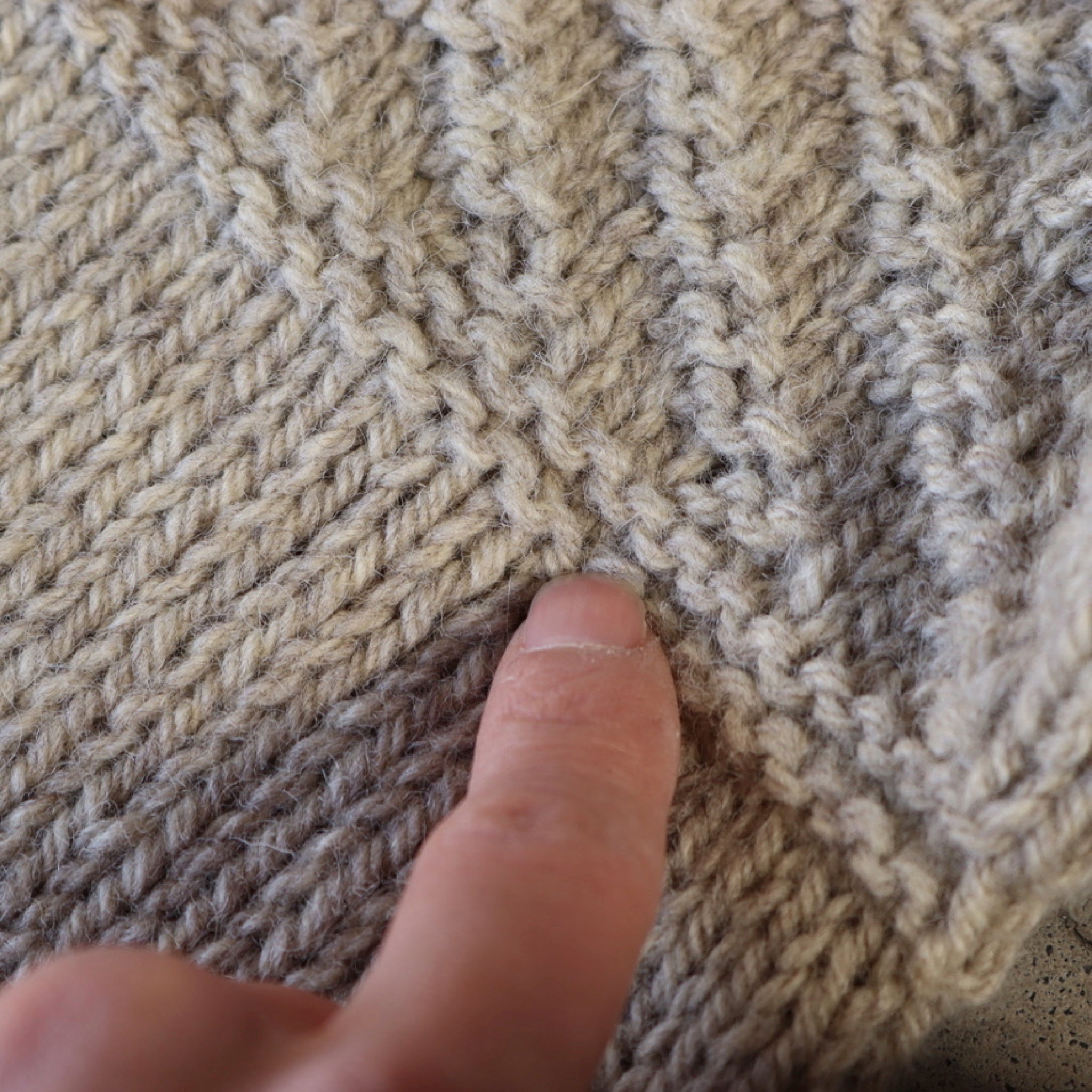
A three-dimensional knitted pattern that extends from the shoulders to the chest.
If you look closely at this part, you can see that it is made up of a single thread connected.


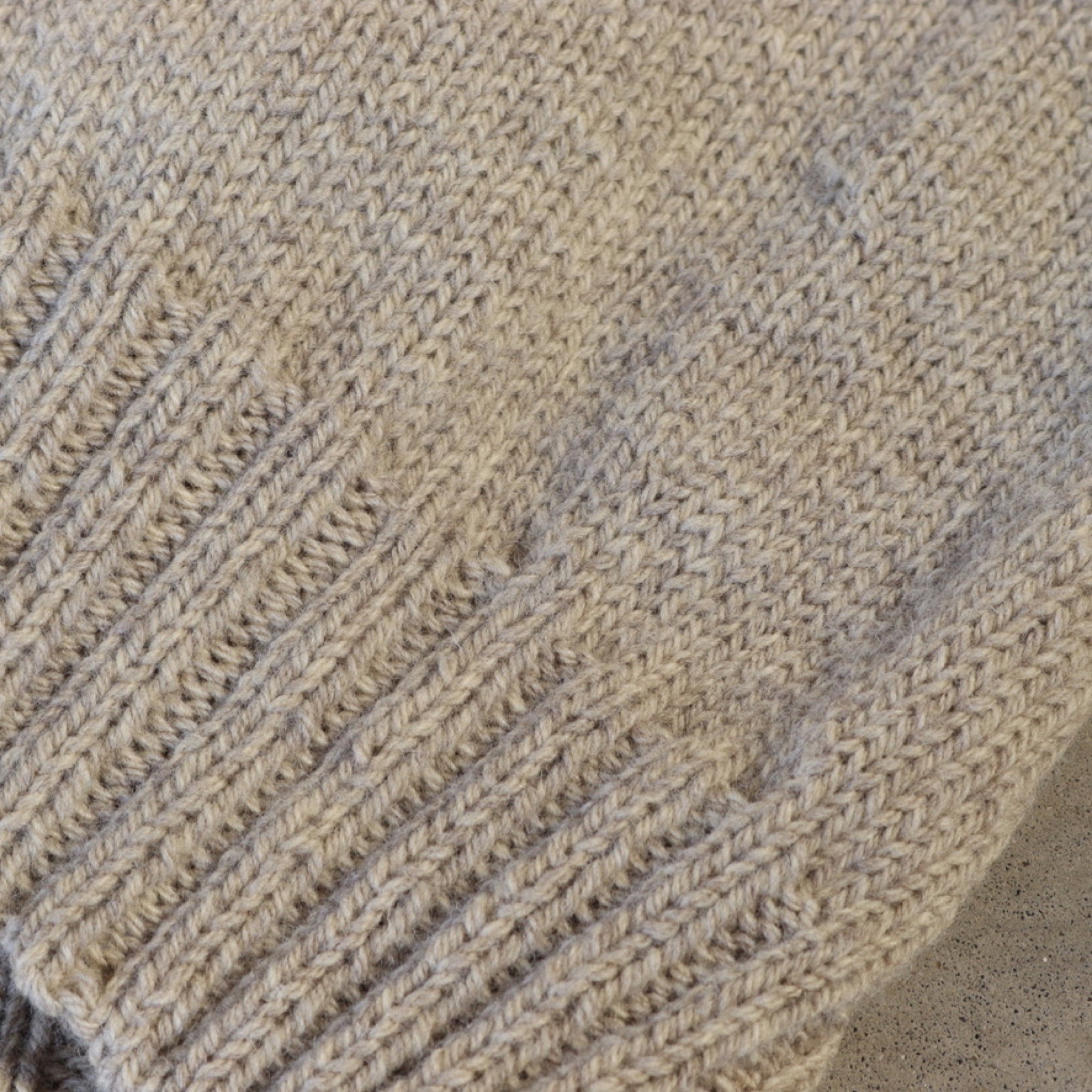
As you can see at the hem, the knitted fabric has been changed.
However, the knitted fabric continues from the body in this area, and is not made from separate parts or sewn.
Also, because one knitter knits each sweater from start to finish, each sweater has its own knitter's quirks, and the tightness of the hem varies slightly from one sweater to the next. different.
I think it's a good thing that's unique to sweaters like this.
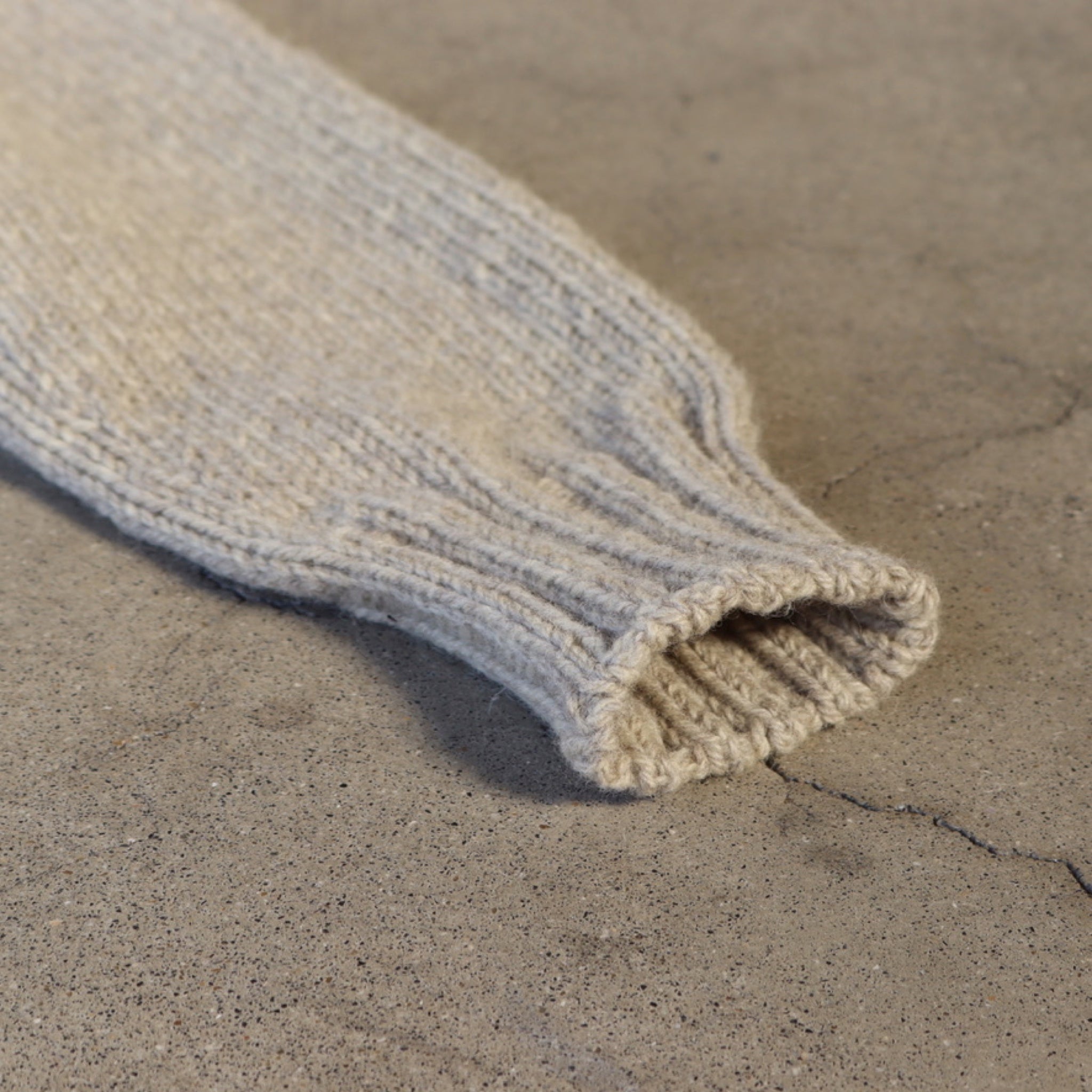
this.
cuff.
The same goes for the cuffs.
Also, do you understand?
The "bulge" in this sweater.
Even when laid flat, it feels as if it is standing against gravity.
It's not just sweaters, it's the same with all clothing, but I feel that the faster things are made, the more likely they are to collapse under the weight of gravity.
Of course, this is not the case with Kesennuma Knitting's sweaters.
The finished product clearly shows that the stitches were carefully knitted, counting each stitch.

The side of the body.
This part also does not switch between the front and back sections, and the front and back are seamlessly connected.
As you get closer to the hem, you can see that the number of stitches decreases little by little.

This is a sleeve.
The sleeves are the same as the hem of the body.
The left side is the body side and the right side is the cuff side, but you can see that the stitches increase one by one as you move towards the left side of the body.
The difficult thing about hand knitting is that it takes a huge amount of time to knit one garment, so of course you need patience, but also because the size dimensions are determined, it is difficult to knit the stitches correctly according to the standard. It's necessary.
Of course, each stitch is knitted by hand, counting each stitch like 1, 2, 3, 4, 5, 6, etc.
For one piece, that's a huge number.
Therefore, along with patience, a high level of concentration is also required.
I don't think anyone can do this type of manufacturing these days.

And the back.
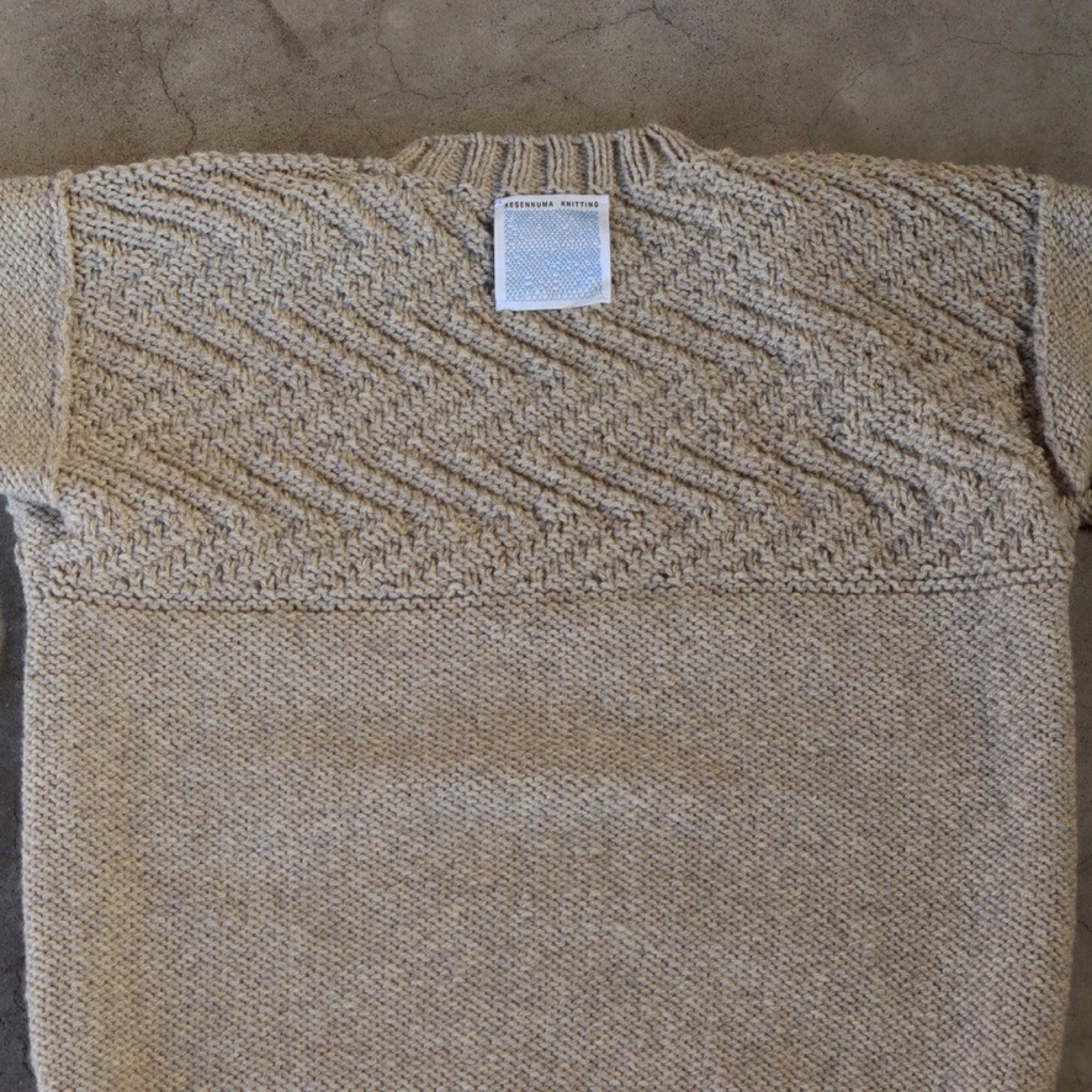
The back is also very neat.
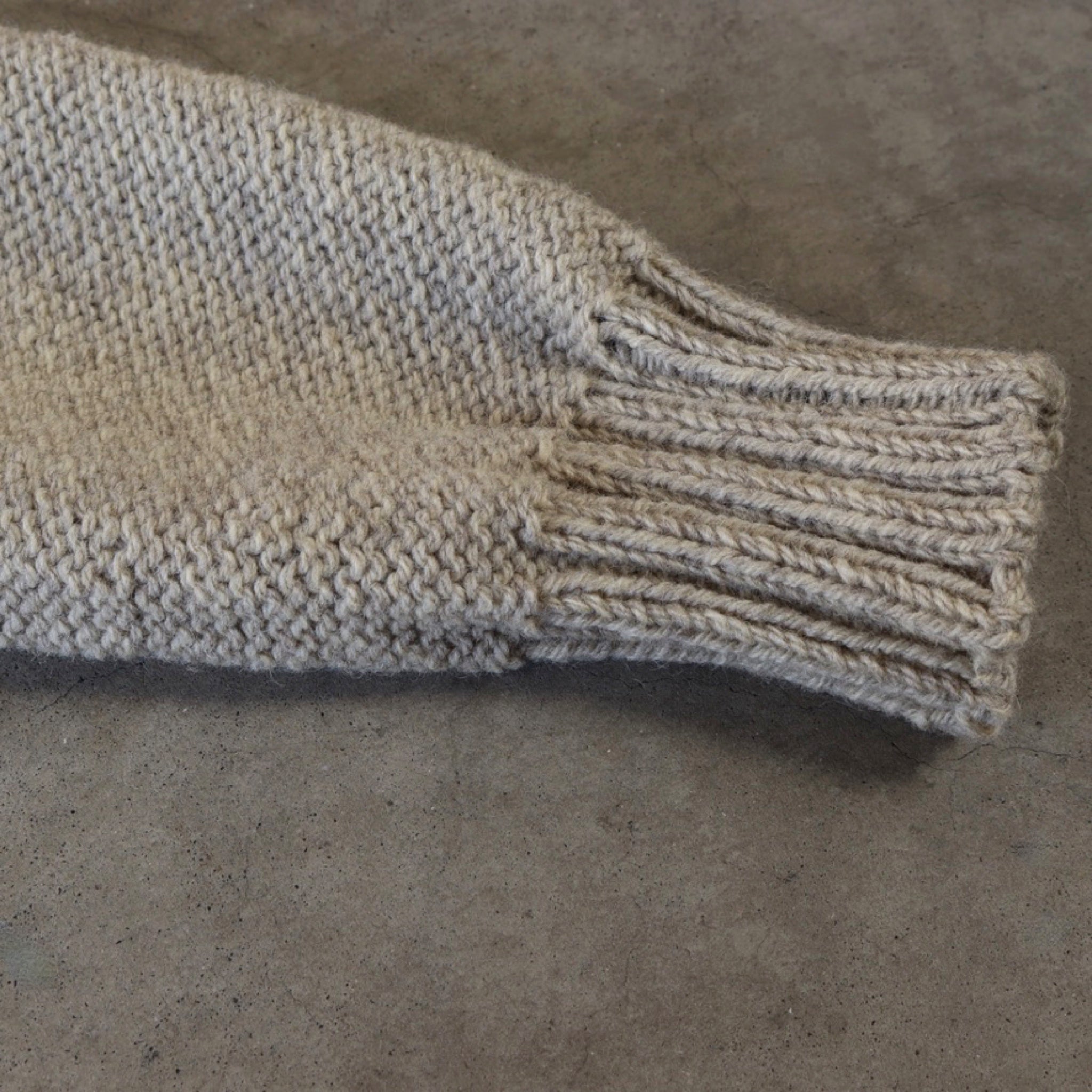
The back side of the cuffs also has a very flat structure that is unique to hand-knitting.
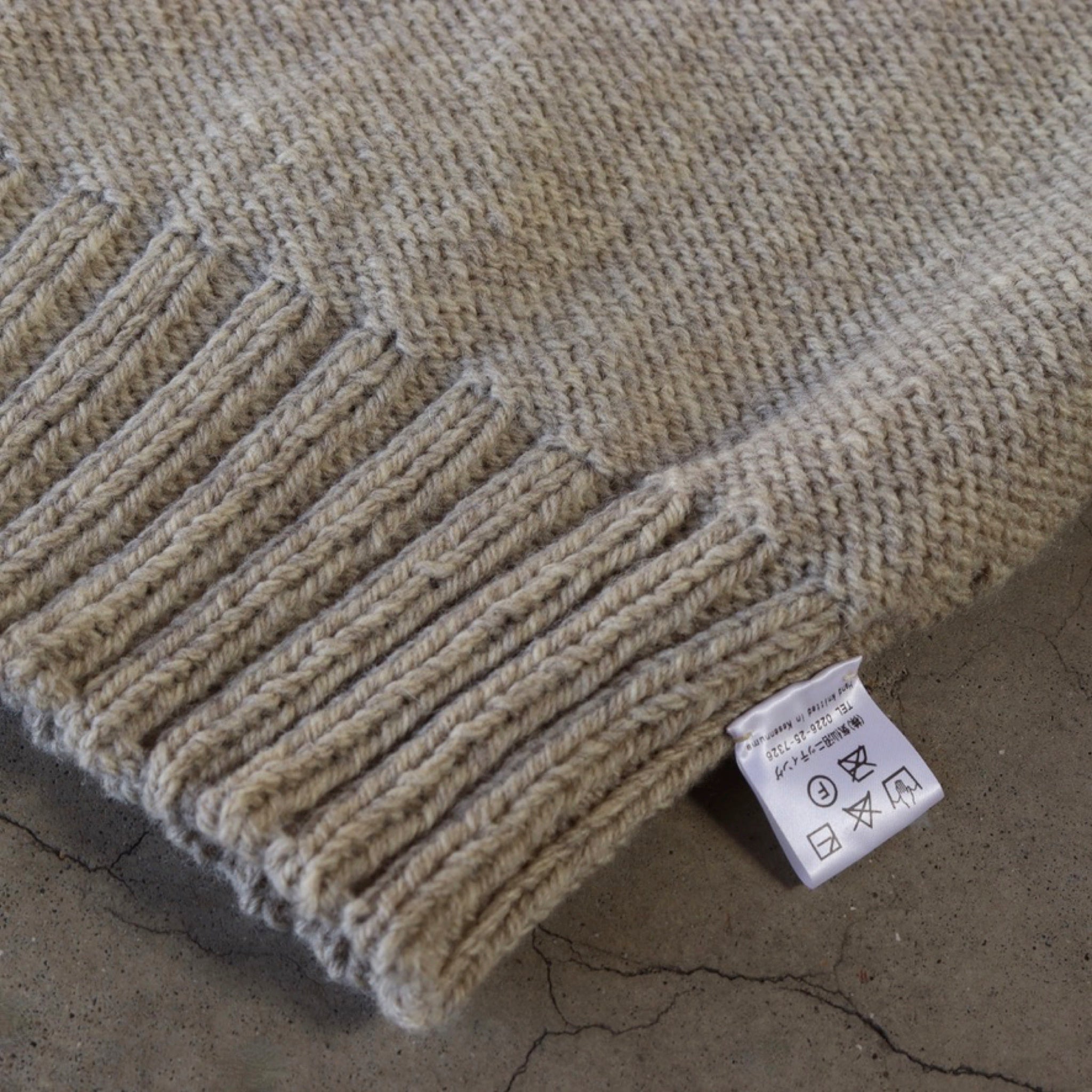
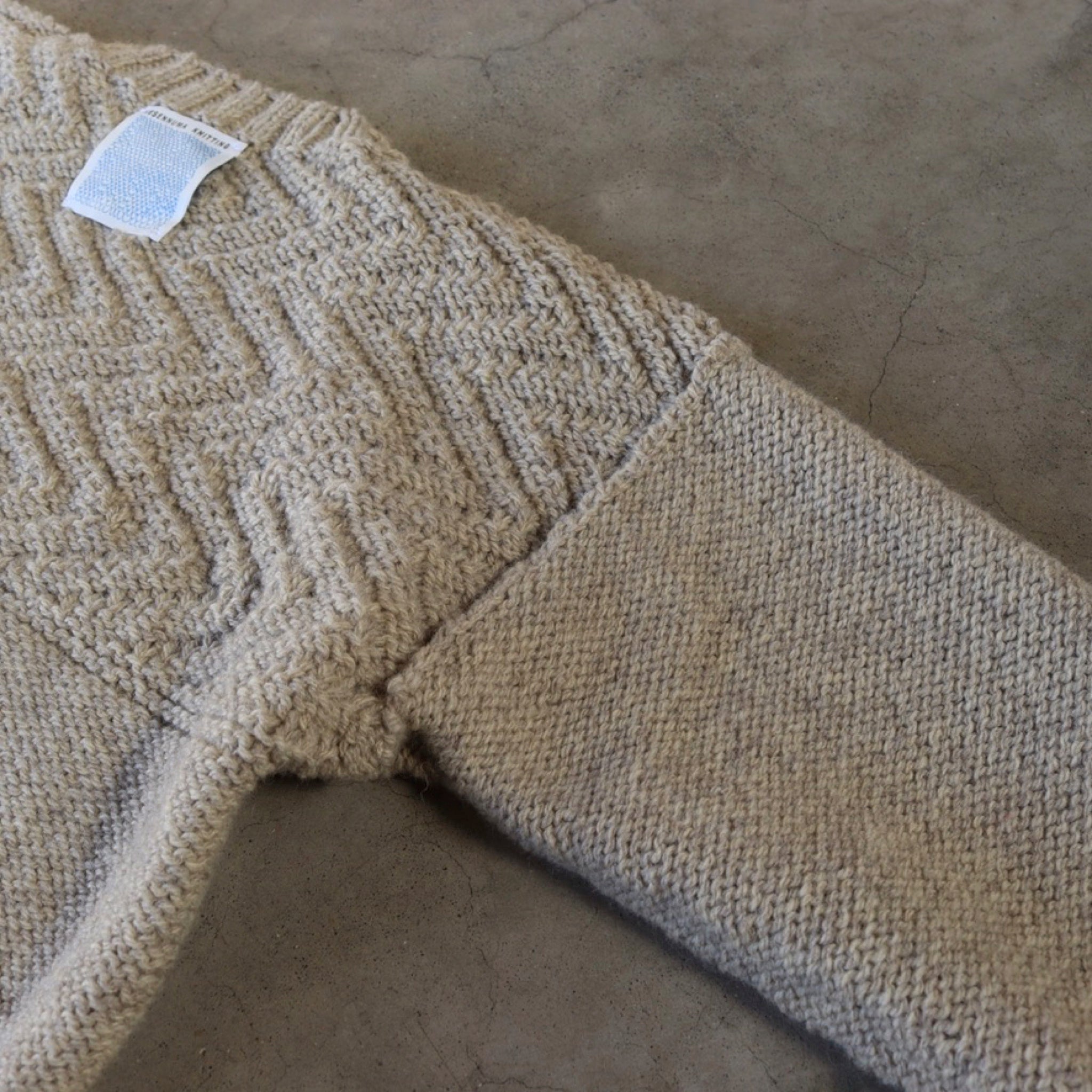
Rather than sewing the armholes, it might be better to say that the body and sleeves are knitted together using the same thread as the main body.
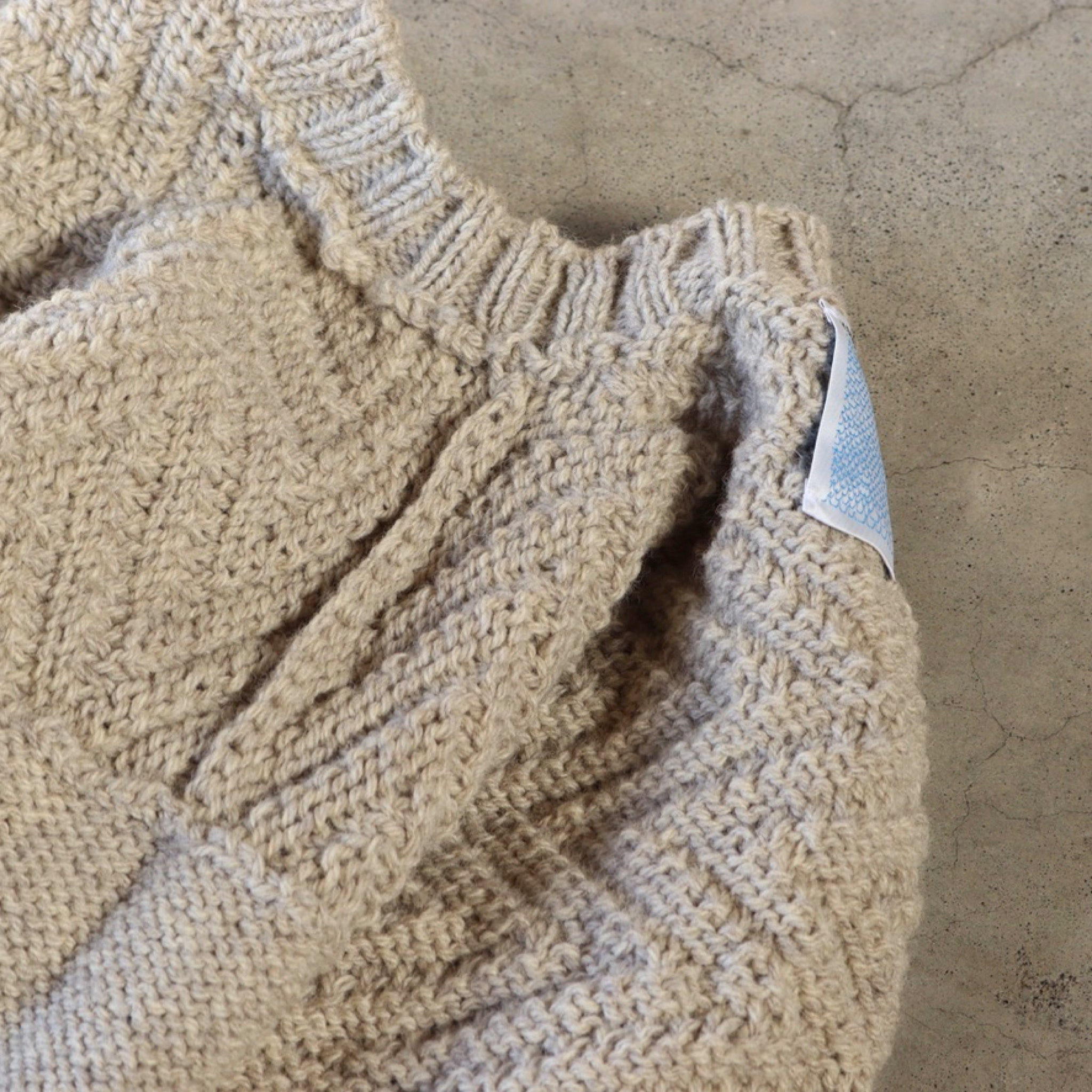
The same goes for the shoulders and neck.
I think that with traditional hand-knitted sweaters like this one, you can feel the unique warmth of the person's hands.
However, this is not an industrial hand-knitting process, and the knitters are responsible for making each garment by their name.
I knit with the hope that the person who receives the sweater I am knitting will like it and feel happy every time they wear it.
Clothes are made by people with people in mind.
We live in a world where everything is progressing at an accelerated pace, but I think things like this can sometimes feel special.
That's why I wanted to introduce this sweater, so I handled it.
I think these are clothes that give you a real sense of warmth.
I would be happy if you could take a look.
